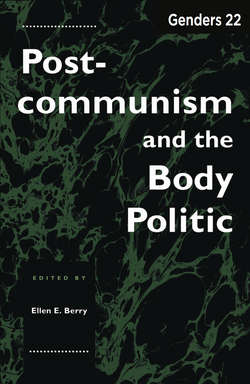Читать книгу Genders 22 - Ellen E. Berry - Страница 15
На сайте Литреса книга снята с продажи.
TWO Engendering the Russian Body Politic
ОглавлениеHarriet Murav
One political myth that has persisted through the greater part of Russian history, regardless of the particular form in which political power was expressed, imagines Russia (both Imperial and Soviet) as consisting of two sometimes opposed entities: the state and the Russian people or nation. The mythologeme of the “Russian people” was well developed by the end of the nineteenth century and exploited most strikingly in the twentieth by Stalin. The opposition between the state and the people or nation is not gender neutral. The state, be it Tsarist or Soviet, is constructed as masculine, and the people or nation as feminine. As Joanna Hubbs shows, the bifurcation between “Father Tsar” and “Mother Russia” can be traced back to the reign of Ivan the Terrible, but a similar division of roles persists throughout the Soviet period.1 Nina Perlina points out that although the Russian word for “revolution” is grammatically feminine, the historical revolution “was largely a masculine undertaking” and was mythologized as such.2
The radical Utopias projected by such revolutionary feminists as Aleksandra Kollantai did little to dislodge traditional Russian gender mythologies. Kollantai, writing in 1921, says that the pregnant woman “ceases to belong to herself — she is in service to the collective — she ‘produces’ out of her own flesh and blood a new unit of work, a new member of the labor republic.”3 According to Kollantai, the needs of the family will be provided by the state in the form of communal housing, communal kitchens, children’s homes, and day-care centers, making it possible for women to combine professional work and family life. This revolutionary restructuring of everyday life was never realized. Furthermore, notwithstanding Kollantai’s Marxist definition of motherhood not as reproduction but as production, Soviet ideology revitalized the traditional myth of Mother Russia.
Maia Turovskaia, a feminist critic writing in post-Soviet Russia, traces the representation of this mythology in films made during the time of Stalin. The 1939 film The Member of the Government constructs the heroine’s genealogy as a creature of the party of Lenin and Stalin — as Turovskaia puts it, as a creature of “an all-encompassing patriarchal Will.” Chosen to become a member of the Supreme Soviet, Aleksandra Sokolova proclaims: “Here I stand before you, a simple Russian woman [she uses the somewhat derogatory term “baba”], beaten by my husband, frightened by the priest, shot at by our enemies. … And the party and our Soviet power elevated us and me as well to this tribune.”4 Turovskaia shows how in the postwar film The Oath the heroine is transformed into a mythologized “Mother Russia.” The heroine presents a letter written by her husband to Lenin to his new incarnation, Stalin, and in so doing embodies, as Turovskaia puts it, “a purely Russian mythology: the Motherland [Rodinamat’] before the face of the Father of nations.”5
Far from disappearing with the last vestiges of Soviet power, this mythology of Mother Russia, together with certain related constructions of the feminine, have reappeared with particular force during recent years, against the backdrop of glasnost, perestroika, and the collapse of the Soviet empire.6 These political changes have also made possible the creation and publication of new forms of criticism, both literary and social. A new generation of writers has appeared, among whom women writers figure importantly. Collections specifically devoted to “women’s writing” — certainly a vague and problematic term — have been steadily published at least since the late 1980s.
This chapter seeks to provide an overview of the reconfiguration of Mother Russia and the responses, both direct and indirect, to her resurrection. I will begin with the writings of politically conservative authors, some of whom are well known outside Russia. I will show how the revision of Mother Russia is itself a response to the perception of a breakdown in the political, social, and natural order. I then turn to a specific response to these writings in the work of two very different authors, both of whom can loosely be identified as politically “liberal.” The last section of the essay examines the prose of several new Russian women authors, tracing how and to what extent their configurations of woman represent “oppositionalist” writing. What strategies are deployed in this writing to defamiliarize Mother Russia? Of particular importance here will be the image of the female body.
